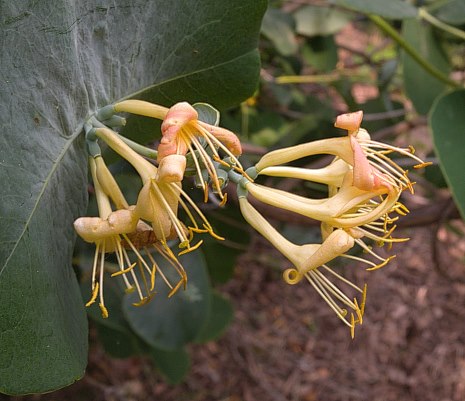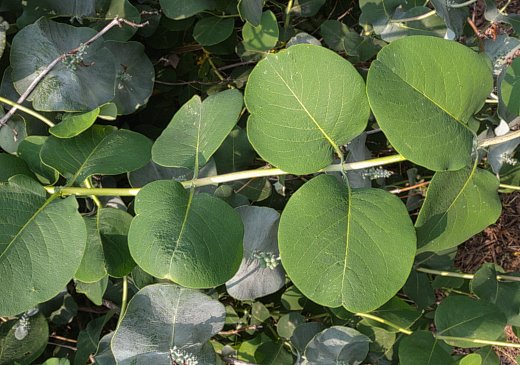
About 2-5 sessile whorls of flowers develop along a short flowering stalk from the uppermost pair of leaves. Sometimes secondary whorls of flowers develop from short axillary stalks from the pair of leaves immediately below the uppermost pair. Individual flowers are about 1" long, consisting of a 2-lipped corolla that is pale yellow to orange-yellow and a short tubular calyx. The upper lip of the corolla consists of 4 short upright lobes, while the lower lip of the corolla consists of a single recurved lobe. The base of the corolla is slightly swollen on one side. Exerted from the throat of each corolla, there are 5 stamens and a single style with a knobby stigma. The filaments of the stamens are nearly hairless, except for some sparse hairs below. The blooming period occurs from late spring to early summer and lasts about 2-3 weeks. Depending on the orientation of the vine, some flowers may dangle from their stalks upside down. The flowers are often fragrant. They are replaced by berries that become about 6-7 mm. long at maturity. At this time, they are orange-red to red, globoid-ovoid in shape, and juicy. Each berry contains a few small seeds about 3 mm. long. In the climate of Illinois, the leaves of this vine are deciduous.
Cultivation: The preference is full sun or partial sun, mesic conditions, and soil containing loam, sand, or rocky material. Light shade is also tolerated, but flowers may not develop.
Range & Habitat: The native Grape Honeysuckle is occasional in northern and central Illinois, but apparently absent from the southern section of the state. Local populations of this vine may be in a state of decline because of herbivory from the large population of White-Tailed Deer and because of the reduced number of wildfires. Habitats consist of rocky upland woodlands, thinly woody bluffs, wooded slopes, woodland borders, savannas and sandy savannas, riverbanks, and thickets. Although it is relatively uncommon in gardens, this woody vine is sometimes cultivated as an ornamental plant.
Faunal Associations: The flowers of Grape Honeysuckle are cross-pollinated by the Ruby-Throated Hummingbird, Hummingbird Clearwing moths (Hemaris spp.), bumblebees, Anthophorine bees (Anthophora spp.), and other long-tongued bees. Other floral visitors include Green Metallic bees and Syrphid flies, which are less effective at cross-pollination because of their small size and mouth parts. Grape Honeysuckle, like other other native honeysuckles (Lonicera spp.), is a host plant of several kinds of insects that feed on the foliage, suck plant juices, etc. These insect feeders include the the caterpillars of such moths as Alucita hexadactyla (Six-Plume Moth), Callizzia amorata (Gray Scoopwing), Hemaris diffinis (Snowberry Clearwing), Hemaris thysbe (Hummingbird Clearwing), Homohadena badistriga (Brown-Lined Sallow), Phyllonorycter fragilella, Phyllonorycter mariaeella, and Ypsolopha dentella (Honeysuckle Moth). It also includes such aphids as Alphitoaphis lonicericola, Gypsoaphis oestlundi, and Hyadaphis foeniculi (Honeysuckle Aphid); and the larvae of Zaraea inflata (Honeysuckle Sawfly). Songbirds occasionally eat the reddish berries, including the Cedar Waxwing, Brown Thrasher, Catbird, Veery, Yellow-Breasted Chat, Purple Finch, and various thrushes. The foliage of honeysuckle vines provide cover and nesting habitat for various songbirds as well. White-Tailed Deer browse on the foliage.
Photographic Location: The Arboretum of the University of Illinois in Urbana, Illinois.

Comments: Some honeysuckles (Lonicera spp.) are shrubs, while others are woody vines. In Illinois, Grape Honeysuckle is one of three native honeysuckles that are woody vines: the other two species are Yellow Honeysuckle (Lonicera flava) and Limber Honeysuckle (Lonicera dioica). Grape Honeysuckle can be distinguished from these other species by the conspicuous white bloom on the upper side of its terminal leaf blades (where the flowers or berries occur). The whorls of flowers on its terminal stalk are usually distinct, while the whorls of flowers of the other two species are more crowded together. Unlike the flowers of Grape Honeysuckle, it is not uncommon for the flowers of Limber Honeysuckle to be tinted brick red or purple. The flowers of Yellow Honeysuckle differ from those of Grape Honeysuckle by lacking one-sided swellings at the bases of their corollas. Another species, the introduced Japanese Honeysuckle (Lonicera japonica), is also a woody vine, except that it can become longer than the native species and it is more aggressive. The berries of Japanese Honeysuckle are purple-black, while those of native honeysuckle vines are orange-red to red. A scientific synonym of Grape Honeysuckle is Lonicera prolifera.